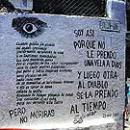Cuba’s Hammel AlleyAn energizing gateway opened 12 years ago
There are small places in the world blessed with a particular enchantment of its own. A case in point is the Hammel Alley, penciled in by scholars of African religions as an energizing gateway wide open to travelers from everywhere under the sun.
It's just a tiny space caught in a neighborhood where an effort of cultural rescue and expansion led by fine artist Salvador Gonzalez has been underway for the last 12 years.
A smuggler's alley
We're talking about an area of Havana that got a bad name some years ago, named after a French-German man who ran by the moniker of Fernando Hammel. During the American Civil War, Mr. Hammel used to smuggle weapons that sometimes washed up to Cuban shores. In the early 20th century, Hammel settled down in Havana, exactly in this dead-end street now bearing his name in the skid row of Cayo Hueso in the municipality of Central Havana.
This cul-de-sac dwelt by humble people transformed itself 12 years ago the moment Salvador –as everybody calls him around here- decided to fish it out of its ill-fated reputation and make it a kingdom of popular culture.
The project
As recounted by young Elias Assef Alfonso –the alley's historian- a friend of the artist's entrusted him to paint an African-Cuban mural in his house, just like the one of his now in display at Old Havana's House of Africa Museum.
The painter sketched out his own idea and splayed a mural in the façade of his friend's house. From April 1990 and in coordination with the alley's neighbors, Salvador painted a huge religious and cultural mural that little by little stretched throughout the entire street for 100 meters of walls now spruced up in their best bib and tucker.
Alfonso believes “the alley is an energizing gateway, the bearer of a hidden energy Salvador has now laid bare through his paintings.”
Salvador has a history of his own, too. He started painting when he was 12 and he has now churned out over 50 works out his easel, all of them linked to African-origin religions hailing from Nigeria and Congo that grew roots in Cuba during the shackled migration of black slaves.
His works are also displayed in such countries as Norway, Sweden, Denmark, the United States and Venezuela.
Despite the fact that Salvador is the author of a couple of murals in Philadelphia, one in New York and another in Norway, the one he created for the Hammel's Alley is the most significant work having the greatest impact in those travelers from all over the globe who come here to feast their eyes on his masterpiece.


































































